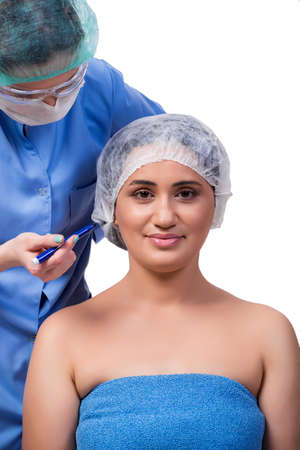Introduction: The Growing Trend of Beauty Treatments Among Indian Minors
In recent years, the beauty and wellness industry in India has seen a noticeable rise in services targeted specifically at children and teenagers. From school-going girls getting their first facials before a family wedding to teenage boys opting for grooming sessions ahead of festivals, beauty treatments are becoming an integral part of young Indians’ lives. This shift is influenced by a blend of cultural expectations, social media trends, and the growing accessibility of salons and spas in both urban and semi-urban areas. Traditionally, personal grooming was something reserved for adults or special occasions, but changing attitudes towards appearance—heavily shaped by Bollywood stars, influencers, and peer groups—have made it more commonplace even among minors. Parents often view these treatments as harmless pampering or a way to boost their child’s confidence in a competitive society. However, this growing trend also raises important questions about safety, consent, and legal guidelines that families must consider before allowing minors to undergo such services.
Common Beauty Treatments for Minors in India
Indias vibrant beauty culture has made personal grooming a significant part of teenage life, especially among urban youth. While trends may differ between cities and smaller towns, several beauty treatments have become popular choices for minors seeking self-expression or simply wishing to follow the latest fads. Here is a look at some of the most common services requested by Indian minors and how they are locally perceived:
| Treatment | Description | Local Perception |
|---|---|---|
| Threading | Eyebrow and facial hair removal using twisted cotton thread | Widely accepted as a coming-of-age ritual, often seen as essential grooming for girls from their early teens |
| Facials | Cleansing, exfoliation, and massage treatments for skin brightening and acne control | Increasingly popular before special occasions; viewed as pampering but sometimes debated if suitable for younger skin |
| Waxing | Removal of body hair using hot or cold wax strips, mostly on arms and legs | Common among older teens, especially before festivals or weddings; parents may be cautious about age appropriateness |
| Hair Colouring | Temporary or permanent dyes to change hair colour, highlights or streaks being favourites | Trendy among urban school-goers, though many schools discourage coloured hair; some parents see it as rebellious |
| Temporary Tattoos & Mehendi | Henna (mehendi) art on hands/feet, stick-on tattoos or airbrush designs | Culturally rooted in celebrations; mehendi is traditional and encouraged, while Western-style tattoos are seen as playful but temporary only for minors |
In metropolitan areas like Mumbai, Delhi, and Bangalore, these treatments are available in salons frequented by families. Salons often promote “kid-friendly” versions—such as fruit-based facials or hypoallergenic products—to address parental concerns. In more conservative regions or smaller towns, these services might still attract scrutiny due to cultural expectations regarding modesty and age-appropriateness.
The perception of beauty treatments for minors also varies widely based on family values. Many parents permit threading and waxing as part of hygiene and social readiness but draw the line at chemical-based processes like hair colouring. Temporary tattoos and mehendi are generally viewed as safe forms of self-expression during festivals such as Diwali or weddings. Still, there is an ongoing dialogue about when it is appropriate for children to start these routines, reflecting Indias blend of tradition and modernity in its approach to beauty.

3. Indian Legal Framework: Regulations and Age Restrictions
When it comes to beauty treatments for minors in India, the legal landscape is still evolving, but certain key regulations and guidelines do exist. As per current Indian law, there is no uniform, nationwide legislation that specifically governs all beauty services for children and teenagers. However, various state governments and municipal bodies have issued advisories regarding the minimum age for accessing specific cosmetic procedures, especially those considered invasive or with long-term effects.
The Ministry of Health and Family Welfare, along with the National Commission for Protection of Child Rights (NCPCR), has periodically highlighted the need to protect minors from potentially harmful practices in salons and clinics. The general consensus among regulatory authorities is that non-medical cosmetic procedures—such as facials, waxing, threading, and hair colouring—should not be performed on children below 18 years without explicit parental consent. For more advanced treatments like chemical peels, laser hair removal, Botox, or fillers, most reputed clinics in cities like Mumbai, Delhi, and Bengaluru strictly adhere to a policy of 18+ only, unless there are genuine medical indications supported by a dermatologist’s recommendation.
In addition to government advisories, professional associations such as the Association of Hairdressers & Cosmetologists of India (AHCI) also encourage their members to exercise caution when providing beauty services to minors. They often conduct training sessions for salon staff to make them aware of both ethical responsibilities and potential legal consequences under the Consumer Protection Act and the Juvenile Justice (Care and Protection of Children) Act if harm is caused due to negligence or lack of informed consent.
Parents are usually required to provide written consent before any procedure is undertaken on a minor. Some premium salons even ask parents to remain present during the treatment for added transparency. This trend is particularly noticeable in metropolitan areas where awareness levels about health and safety are higher.
Despite these guidelines, enforcement remains inconsistent across different regions of India. In rural or semi-urban areas, informal salons may not always follow official protocols due to lack of awareness or oversight. This makes parental vigilance essential while choosing where their children go for beauty services.
As the beauty industry continues to boom across India—with social media trends fuelling demand among younger clients—it becomes even more critical for both service providers and parents to stay updated about regulatory developments and best practices concerning minors’ safety.
4. The Role of Parental Consent in Beauty Procedures
In India, the issue of parental consent for beauty treatments involving minors is a significant topic among families and salon professionals alike. Unlike Western countries where protocols might be more standardised, the practice in Indian cities and towns can vary widely depending on local culture, awareness, and the specific beauty service being sought. Salons are increasingly cautious about adhering to legal and ethical guidelines, especially when dealing with clients under 18 years old.
When Do Salons Request Parental Consent?
Most reputable salons in metro cities such as Mumbai, Delhi, and Bengaluru have a clear policy that requires minors to be accompanied by a parent or guardian when requesting certain services—especially those that involve semi-permanent changes or chemicals, like hair colouring, waxing, or skin treatments. In smaller towns, practices may be less formalised but are evolving with rising awareness.
Typical Practices for Obtaining Consent
Salons generally follow one of these approaches to obtain parental consent:
| Method | Description | Common in |
|---|---|---|
| Written Consent Form | A physical form signed by the parent/guardian detailing the treatment and potential risks. | Urban salons and chains |
| Verbal Consent On-Site | Parent or guardian provides verbal approval in person before the treatment begins. | Towns and independent salons |
| Parental Presence Required | The parent must be present throughout the procedure for supervision and immediate approval. | Boutique salons; sensitive procedures everywhere |
| No Formal Consent | No structured process; usually found in small towns or unregulated setups. | Rural areas (declining practice) |
Real-Life Scenarios: Parents & Salons Navigating Consent
Consider the case of Mrs. Sharma from Pune whose 15-year-old daughter wanted a facial before a family wedding. The salon insisted on her signing a consent form and explained all products that would be used. Mrs. Sharma appreciated this transparency, which helped build trust. In contrast, in a tier-2 city like Indore, a father was surprised when asked to stay during his son’s first haircut at a new unisex salon—a practice now becoming common even for seemingly simple procedures due to increasing awareness of child safety.
Cultural Sensitivities & Challenges
Indian parents often approach beauty treatments for minors with caution due to cultural expectations regarding age-appropriate grooming and societal perceptions. Some parents may resist procedures like waxing or hair colour for younger children, while others embrace them as part of modern urban life. Salons find themselves mediating these concerns by providing information sessions or pre-treatment consultations tailored to family needs.
5. Cultural and Social Considerations
When discussing beauty treatments for minors in India, it is essential to understand the deep-rooted cultural and social factors that influence community attitudes and family decisions. The Indian society is a complex blend of tradition and modernity, where expectations regarding appearance often intersect with long-standing values. Family dynamics play a significant role in shaping a minor’s experience with aesthetics, as parental authority and collective decision-making remain strong features of Indian households.
Many communities view beauty treatments for minors through a traditional lens, emphasizing natural beauty and modesty. There is often an unspoken belief that children should not be exposed to adult standards of grooming too early. Yet, urban centers and metropolitan areas are witnessing a shift, with increasing acceptance of modern beauty practices among teenagers, influenced by media, Bollywood celebrities, and international trends. This urban-rural divide creates varying perspectives even within the same family or community group.
The intersection of these two worlds — the conservative values of elders and the aspirational views of younger generations — can sometimes lead to friction. For instance, while a mother may consent to her daughter getting a simple facial before a family wedding, she might hesitate at more advanced procedures like chemical peels or laser treatments. Extended families, including grandparents and uncles, may also voice opinions, reflecting the collective nature of decision-making in Indian culture.
Furthermore, there is an element of social status attached to beauty treatments in many parts of India. Attending salons or undergoing certain procedures can be seen as a sign of affluence or modern outlook. However, this can also create pressure on both minors and their parents to conform to new norms in order to maintain social standing within their peer groups.
Ultimately, navigating beauty treatments for minors in India is not just about following legal guidelines or obtaining parental consent; it also involves balancing respect for tradition with openness to changing societal norms. This delicate negotiation highlights how deeply personal and culturally specific these choices can be for Indian families.
6. Awareness, Safety, and Best Practices for Parents and Salons
Empowering Parents: Making Informed Decisions
In India, the trend of minors seeking beauty treatments is on the rise, making it crucial for parents to be well-informed before granting consent. Understanding the type of treatment, its necessity, potential side effects, and age-appropriateness is essential. Parents should have open conversations with their children about body image and self-esteem, ensuring that any decision to pursue beauty services stems from genuine need rather than peer pressure or social media influence.
Choosing the Right Salon: What to Look For
Selecting a reputable salon is fundamental for child safety. Parents should look for salons that are registered with local authorities and have licensed beauticians familiar with treating younger clients. It is advisable to visit the salon beforehand, observe their cleanliness protocols, and inquire about staff training specific to minors’ needs. Word-of-mouth recommendations from other parents in your community can also be valuable.
Hygiene Standards: Non-Negotiable Factors
Hygiene is non-negotiable when it comes to beauty treatments for minors in India. Ensure that the salon uses sterilised tools, disposable products where possible, and follows strict sanitation practices between clients. Ask about patch tests for skin treatments like waxing or facials to prevent allergic reactions. Parents should not hesitate to walk away if they find hygiene standards lacking — safety must always come first.
Child Safety During Treatments
For any minor undergoing a beauty procedure, parental presence or supervision is highly recommended. Discuss with the beautician beforehand about what the treatment involves, expected duration, and aftercare instructions. Encourage your child to speak up if they feel uncomfortable at any point during the service. Clear communication builds trust between parents, children, and salon staff.
Guidance for Salon Owners
Salon owners in India have a responsibility to adhere strictly to legal guidelines regarding minors. Displaying parental consent forms prominently and maintaining detailed records protects both the business and clients. Training staff on handling young customers with sensitivity and ensuring all products used are age-appropriate will set your salon apart as a safe choice for families. It’s also wise to regularly update knowledge on state regulations concerning underage beauty services.
By fostering an environment of awareness and prioritising safety measures, both parents and salon professionals can ensure that beauty treatments for minors remain a positive experience in line with Indian cultural values and legal expectations.
7. Conclusion: Looking Ahead
As we reflect on the current landscape of beauty treatments for minors in India, it becomes clear that the balance between evolving societal trends and safeguarding the well-being of young individuals is both delicate and essential. The legal framework, though developing, provides a foundation for protecting minors by mandating parental consent and setting age-related guidelines for various procedures. Yet, the rising influence of social media, peer pressure, and changing standards of beauty continue to drive demand among Indian teenagers, sometimes outpacing regulation.
Looking ahead, it is crucial for all stakeholders—parents, salons, clinics, educators, and policymakers—to adopt a collaborative and responsible approach. Prioritising informed consent, transparent communication, and cultural sensitivity will be key to ensuring that beauty treatments remain safe and appropriate for minors. More awareness campaigns and community dialogues can help demystify procedures, dispel myths, and empower both parents and minors to make well-considered decisions.
Ultimately, as India’s beauty industry continues to expand and modernise, fostering an environment where the physical and emotional health of minors is paramount should remain at the core of every practice. By upholding ethical standards and nurturing open conversations about self-image and confidence, we can look forward to a future where beauty treatments enhance—not compromise—the well-being of India’s youth.

